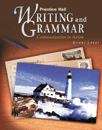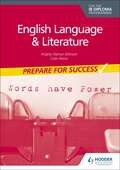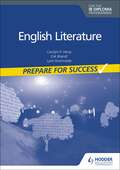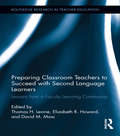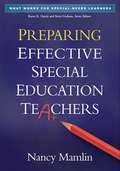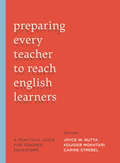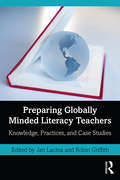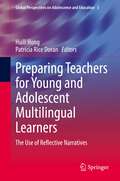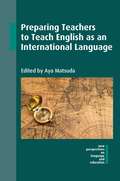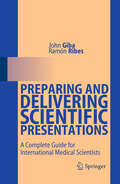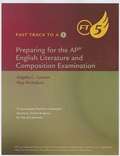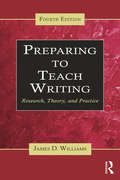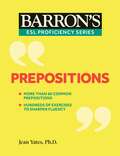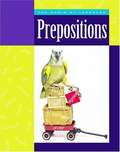- Table View
- List View
Prentice Hall Writing and Grammar: Ruby Level (Handbook Edition)
by Joyce Armstrong Carroll Gary Forlini Edward E. WilsonYou may not be aware of how heavily you rely on writing every day. At home, you might jot down a "To Do" list, take a phone message, send a letter or an e-mail, or fill out an application or order form.
Prentice Hall Writing and Grammar: Silver Level
by Joyce Armstrong Carroll Gary Forlini Edward E. WilsonThis book equips students with the tools they require to achieve good communication through writing.
Prentice Hall: The Reader's Journey, Grade Eight
by PearsonThis guide explores The Reader's Journey, an innovative, novel-based language arts program designed for students in Grades 6-8. The Reader's Journey uses high-interest, leveled Anchor Books to engage students at their reading levels, and the program supports systematic development of core language arts skills.
Prentice-Hall Literature: The American Experience (Fourth Edition)
by Prentice-HallPrentice Hall Literature The American Experience is a student textbook.
Preparación para la evaluación de Texas [Grado 2] (¡Arriba la Lectura!)
by Houghton Mifflin Harcourt Publishing CompanyNIMAC-sourced textbook
Preparación para la evaluación de Texas [Grado 3] (¡Arriba la Lectura!)
by AvisoNIMAC-sourced textbook
Preparación para la evaluación de Texas [Grado 4] (¡Arriba la Lectura!)
by Houghton Mifflin Harcourt Publishing CompanyNIMAC-sourced textbook
Prepare for Success: English Language and Literature for the IB Diploma
by Angela Stancar Johnson Colin PierceStretch your students to achieve their best grade with this year-round course companion; providing clear and concise explanations of all syllabus requirements and topics, and exam practice questions to support and strengthen learning.- Practice and revise skills - exam practice boxes throughout with questions for paper 1 and paper 2 with genuine example answers. - Achieve the best grades - expert advice on how to approach and explore a topic for the IA and HL essay plus Learner Portfolio activities and tips on how to present work.- Build confidence and strengthen skills - guidance on how to encompass the areas of exploration, concept connections and global issues from the new course structure into answers. Focus revision - key terms and definitions listed for each topic/subtopic.
Prepare for Success: English Language and Literature for the IB Diploma
by Angela Stancar Johnson Colin PierceStretch your students to achieve their best grade with this year-round course companion; providing clear and concise explanations of all syllabus requirements and topics, and exam practice questions to support and strengthen learning.- Practice and revise skills - exam practice boxes throughout with questions for paper 1 and paper 2 with genuine example answers. - Achieve the best grades - expert advice on how to approach and explore a topic for the IA and HL essay plus Learner Portfolio activities and tips on how to present work.- Build confidence and strengthen skills - guidance on how to encompass the areas of exploration, concept connections and global issues from the new course structure into answers. Focus revision - key terms and definitions listed for each topic/subtopic.
Prepare for Success: English Literature for the IB Diploma
by Carolyn P. Henly Erik Brandt Lynn KrumviedaStretch your students to achieve their best grade with this year-round course companion; providing clear and concise explanations of all syllabus requirements and topics, and exam practice questions to support and strengthen learning.- Practice and revise skills - exam practice boxes throughout with questions for paper 1 and paper 2 with genuine example answers. - Achieve the best grades - expert advice on how to approach and explore a topic for the IA and HL essay plus Learner Portfolio activities and tips on how to present work.- Build confidence and strengthen skills - guidance on how to encompass the areas of exploration, concept connections and global issues from the new course structure into answers. - Focus revision - key terms and definitions listed for each topic/subtopic.
Prepare for Success: English Literature for the IB Diploma
by Carolyn P. Henly Erik Brandt Lynn KrumviedaStretch your students to achieve their best grade with this year-round course companion; providing clear and concise explanations of all syllabus requirements and topics, and exam practice questions to support and strengthen learning.- Practice and revise skills - exam practice boxes throughout with questions for paper 1 and paper 2 with genuine example answers. - Achieve the best grades - expert advice on how to approach and explore a topic for the IA and HL essay plus Learner Portfolio activities and tips on how to present work.- Build confidence and strengthen skills - guidance on how to encompass the areas of exploration, concept connections and global issues from the new course structure into answers. - Focus revision - key terms and definitions listed for each topic/subtopic.
Preparing Classroom Teachers to Succeed with Second Language Learners: Lessons from a Faculty Learning Community (Routledge Research in Teacher Education)
by Thomas H. Levine Elizabeth R. Howard David M. MossThis volume identifies resources, models, and specific practices for improving teacher preparation for work with second language learners. It shows how faculty positioned themselves to learn from resources, experts, preservice teachers, their own practice, and each other. The teacher education professionals leverage their experience to offer theoretical and practical insights regarding how other faculty could develop their own knowledge, improve their courses, and understand their influence on the preservice teachers they serve. The book addresses challenges others are likely to experience while improving teacher preparation, including preservice teacher resistance, the challenge of adding to already-packed courses, the difficulty of recruiting and retaining busy faculty members, and the question of how to best frame the larger issues. The authors also address options for integrating the work of improving teacher preparation for linguistic diversity into a variety of different teacher education program designs. Finally, the book demonstrates a data-driven approach that makes this work consistent with many institutions’ mandate to produce research and to collect evidence supporting accreditation.
Preparing Effective Special Education Teachers
by Nancy MamlinWhat tools are in the toolkit of an excellent special educator, and how can teacher preparation programs provide these tools in the most efficient, effective way possible? This practical, clearly written book is grounded in current research and policy as well as the author's extensive experience as a teacher educator. It identifies what special education teachers need to know to work competently with students with a wide variety of learning challenges and disabilities. Chapters present specific guidelines for helping teacher candidates build critical skills for instruction and assessment, get the most out of field placements, and collaborate successfully with other school personnel and with parents.
Preparing Every Teacher to Reach English Learners: A Practical Guide for Teacher Educators
by Joyce W. Nutta Kouider Mokhtari Carine Strebel2013 Outstanding Book Award, American Association of Colleges for Teacher Education (AACTE)Preparing Every Teacher to Reach English Learners presents a practical, flexible model for infusing English learner (EL) instruction into teacher education courses. The editors outline the key steps involved in this approach—winning faculty support, assessing needs, and developing capacity—and share strategies for avoiding pitfalls. The central chapters feature sample courses illustrating how EL content can be incorporated into standard courses (human development, learning disabilities, and social foundations) and across subject areas and topics (math, science, social science, physical education, and classroom management). Most preservice teacher candidates report that they feel unprepared to work with English learners. This practical, flexible model for infusing EL content into teacher education will provide an invaluable resource in shaping the next generation of teachers.
Preparing Globally Minded Literacy Teachers: Knowledge, Practices, and Case Studies
by Jan Lacina Robin GriffithThis textbook brings together internationally renowned scholars to provide an overview of print and digital literacy instruction for pre-service teachers and teacher educators. It examines historical and cultural contexts of literacy practices around the globe, and addresses issues that teachers need to consider as they teach children from diverse world cultures, languages, and backgrounds. Organized into three Parts—Early Literacy, Intermediate to Adolescent Literacy, and Case Studies—the text highlights key practices around the world to provide literacy educators and students with a broader view of effective practices as well as strategies for overcoming challenges faced by literacy educators worldwide. The global case studies present complex issues and allow readers to discuss what it means to be globally minded, as well as how to implement best practices in literacy instruction. All chapters include consistent elements for ease of use, such as vignettes, historical and cultural contexts, implications for future research, and discussion questions. Grounded in current research and theory, this book is designed for foundational courses in literacy education and literacy methods, as well as courses in comparative and multicultural education.
Preparing Teachers for Young and Adolescent Multilingual Learners: The Use of Reflective Narratives (Global Perspectives on Adolescence and Education #3)
by Patricia Rice Doran Huili HongMultilingual learners (MLs) students spend most of their school time with their teachers, who often feel professionally unprepared to meet their linguistically diverse students' needs. As such, preparing teachers for increasing numbers of multilingual learners (MLs) has become a critical factor in promoting equity and success for all students in our global society. This book explores and highlights the reflective narratives of teacher educators, in-service, and preservice teachers. It shows how these narratives are grounded in their personal lives, professional training, and daily teaching, and how they can unfold the complexities in their various experiences and the rich implications for MLs teaching and teacher preparation. The book presents papers that utilize teachers' reflective narratives to prepare and train teachers who are or will be working with MLs. It discusses the challenges and implications of teaching groups of MLs made up of diverse learners, including immigrants, refugees, and learners with disabilities. 'This book seeks to change the narrative of some of our most vulnerable student populations by giving voice to the experiences, challenges, success, and best practices encountered in the international education landscape. The power contained within each chapter is the systematic and intentional reflections that bring the marginalized stories to the center of the discussion. Anyone seeking an understanding of how reflective narrative can build equity and social justice for multilingual learners will appreciate the breadth of experience described. This understanding is critical for culturally and linguistically diverse teaching and learning.' Jordan González, Ph.D., St. John's University, NY
Preparing Teachers to Teach English as an International Language
by Aya MatsudaThis book explores ways to prepare teachers to teach English as an International Language (EIL) and provides theoretically-grounded models for EIL-informed teacher education. The volume includes two chapters that present a theoretical approach and principles in EIL teacher education, followed by a collection of descriptions of field-tested teacher education programs, courses, units in a course, and activities from diverse geographical and institutional contexts, which together demonstrate a variety of possible approaches to preparing teachers to teach EIL. The book helps create a space for the exploration of EIL teacher education that cuts across English as a Lingua Franca, World Englishes and other relevant scholarly communities.
Preparing and Delivering Scientific Presentations: A Complete Guide for International Medical Scientists
by Ramón Ribes John GibaThe latest in Springer's "Medical English" series, aimed at health care professionals who need English for their work but do not speak English on a day-to-day basis. Although much of the information provided will be useful for scientists of all backgrounds and nationalities, the book is aimed especially at non-native English-speaking physicians and biomedical scientists. It offers clear advice on a variety of topics relevant to the successful preparation and delivery of scientific presentations. Alongside guidance on the actual preparation and delivery of talks, helpful information is provided on such potential difficulties as dealing with questions, chairing sessions, and use of appropriate English. The book will offer encouragement for those embarking on a career in international science as well as practical advice on how to deal with a wide range of situations that may develop in the context of an international congress.
Preparing for the ACT English and Reading: All You Need to Ace the ACT
by Robert PostmanOverview and Introduction, English, Reading, Model English and Reading Tests, The ACT Writing Test.
Preparing for the AP: English Literature and Composition Examination
by Angelia C. Greiner Skip NicholsonNIMAC-sourced textbook
Preparing to Teach Writing: Research, Theory, and Practice
by James D. WilliamsPreparing to Teach Writing, Fourth Edition is a comprehensive survey of theories, research, and methods associated with teaching composition successfully at the middle, secondary, and college levels. Research and theory are examined with the aim of informing teaching. Practicing and prospective writing teachers need the information and strategies this text provides to be effective and well prepared for the many challenges they will face in the classroom. Features Current—combines discussions and references to foundational studies that helped define the field of rhetoric and composition, with updated research, theories, and applications Research based—thorough examination of relevant research in education, literacy, cognition, linguistics, and grammar Steadfast adherence to best practices based on how students learn and on how to provide the most effective writing instruction A Companion Website provides sample assignments and student papers that can be analyzed using the research and theory presented in the text.
Preposition Placement in English
by Thomas HoffmannPreposition placement, the competition between preposition stranding (What is he talking about?) and pied-piping (About what is he talking?), is one of the most interesting areas of syntactic variation in English. This is the first book to investigate preposition placement across all types of clauses that license it, such as questions, exclamations and wh-clauses, and those which exhibit categorical stranding, such as non-wh relative clauses, comparatives, and passives. Drawing on over 100 authentic examples from both first-language (English) and second-language (Kenyan) data, it combines experimental and corpus-based approaches to provide a full grammatical account of preposition placement in both varieties of English. Although written within the usage-based construction grammar framework, the results are presented in theory-neutral terminology, making them accessible to researchers from all syntactic schools. This pioneering volume will be of interest not only to syntacticians, but also second language researchers and those working on variation in English.
Prepositions (Barron's ESL Proficiency)
by Jean Yates Ph.D.Barron&’s ESL Proficiency Series: Prepositions provides comprehensive coverage of this most difficult topic in English grammar. The idiosyncratic nature of prepositions often makes them a barrier to achieving English language proficiency. Jean Yates offers clear explanations with lots of examples and opportunities to practice. Content is organized into simple 15-minute units each of which has its own practice exercises. An answer key is included in the back of the book. The ESL Profiency Series is a valuable tool for ESL teachers, tutors and learners who want to advance their English language skills for work, school or to prepare for proficiency tests such as TOEFL, IELTS, or TOEIC. It is ideal for independent study.
Prepositions (The Magic of Language)
by Ann HeinrichsWhere can you find prepositions? Are they under a rock? Around the corner? Over a hill? The easiest place to find them is right here in this book! Young readers will learn all about prepositions and how to use them.

